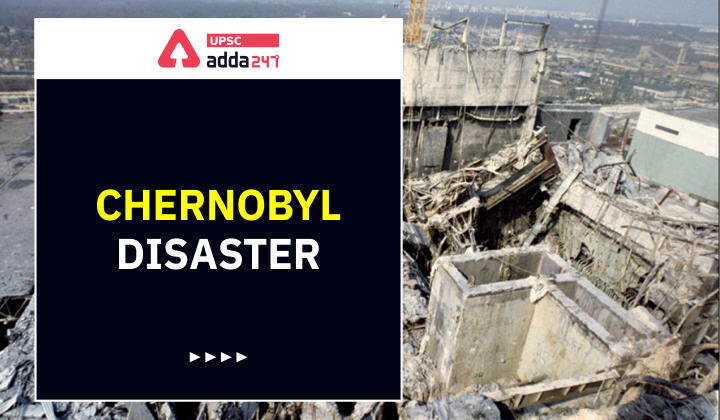Table of Contents
Chernobyl Disaster
Recently, Russian troops captured the Chernobyl nuclear plant in northern Ukraine. Experts are of the opinion that Russia wants the now-shuttered power plant because of its location. In this article, we will discuss about the various aspects of Chernobyl disaster upsc, which could be important for the UPSC IAS exam.
Where is Chernobyl?
- Chernobyl lies about 10 miles from Ukraine’s border with Belarus and about 65 miles to Kyiv, Ukraine’s capital.
- Chernobyl is located on the shortest route from Belarus to Kyiv.
- Chernobyl doesn’t have any military significance but sits on one of the four “axes” Russian forces used to invade Ukraine.
Why Russia captured Chernobyl?
- The most obvious reason is the location of Chernobyl.
- The capture of Chernobyl may also be a signal from Russian President to the West and NATO to not interfere with his plans.
- Some experts are also of the opinion that Russians want to ensure that nuclear safeguards are in place and they will not be responsible for any accidents.
- Experts say that Russia don’t want to give the Ukrainians an opportunity to blow up the damaged reactor number four, which blew up back in 1986 as an act of defensive deterrence to contaminate the nearby areas to halt the rapid advance of the Russian military.
What is Chernobyl disaster?
- In 1986, fire and explosion occurred at Chernobyl nuclear power station, making it the worst disaster in the history of nuclear power generation.
- Experts said that the fourth reactor at the Chernobyl plant exploded during a botched safety test.
- The resulting steam explosion and fires released at least 5% of the radioactive reactor core into the environment, with the deposition of radioactive materials in many parts of Europe.
- After the core explosion, a radioactive cloud drifted across much of Europe. The radioactivity of the area around the plant has decreased in the decades since the disaster, according to the World Nuclear Association.
- Chernobyl Unit 2 was shut down after a 1991 fire, and Unit 1 remained on-line until 1996. Chernobyl Unit 3 continued to operate until 2000, when the nuclear power station was officially decommissioned.
Chernobyl disaster reasons
- Chernobyl accident was the product of a severely flawed Soviet-era reactor design, combined with operations of inadequately trained personnel.
- Much of the underlying circumstances were particular to the Chernobyl reactor and the Soviet government’s response.
Flawed design
- The reactor built at Chernobyl was a RBMK reactor, which was never built by any country outside the USSR because it had characteristics that were rejected everywhere outside the Soviet Union.
- RBMK reactor is inherently instable, especially during startup and shutdown.
- Because of the way the reactor used graphite where American reactors use water, when Soviet operators tried to reduce power the RBMK had a tendency to sharply increase power production instead.
- As overheating became more severe, power increased even more.
Untrained personnel
- In a poorly designed experiment, workers shut down the reactor’s power-regulating system and its emergency safety systems, and withdrew most of the control rods from its core while allowing the reactor to continue running at 7 percent power.
- These mistakes were compounded by others, and at 1:23 am on April 26 the chain reaction in the core went out of control.
- It was followed by several explosions, thus triggering a large fireball and blowing off of the heavy steel and concrete lid of the reactor.
- This and the ensuing fire in the graphite reactor core released large amounts of radioactive material into the atmosphere, where it was carried great distances by air currents.
- A partial meltdown of the core also occurred.
Chernobyl disaster consequences
- Some sources state that while two people were killed in the initial explosions at the plant, around 50 people died due to the reactions that followed.
- Between 50 and 185 million curies of radionuclides (radioactive forms of chemical elements) escaped into the atmosphere—several times more radioactive than that created by the atomic bombs dropped on Hiroshima and Nagasaki, Japan.
- The radioactive elements were spread by the wind over Belarus, Russia, and Ukraine and soon reached as far west as France and Italy.
- Millions of acres of forest and farmland were contaminated, and, although many thousands of people were evacuated, hundreds of thousands more remained in contaminated areas.
- In addition, in the following years, many livestock were born deformed, and among humans several thousand radiation-induced illnesses and cancer deaths were expected in the long term.
Read recent news for UPSC




 TSPSC Group 1 Question Paper 2024, Downl...
TSPSC Group 1 Question Paper 2024, Downl...
 TSPSC Group 1 Answer key 2024 Out, Downl...
TSPSC Group 1 Answer key 2024 Out, Downl...
 Cabinet Ministers of India 2024, New Cab...
Cabinet Ministers of India 2024, New Cab...







